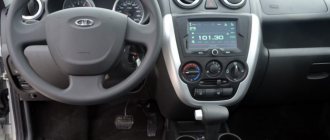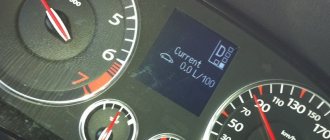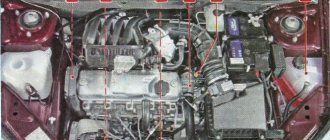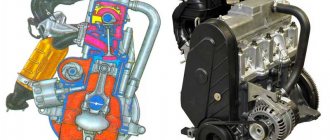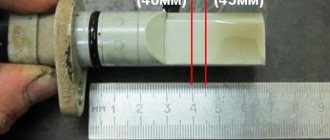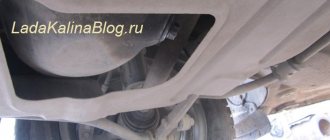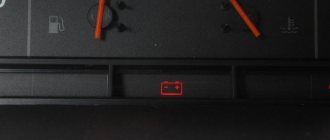For what other reasons might the lights on the dashboard start to light up?
According to experts, faults in electronics can also cause indexing. Icons may appear involuntarily on the dashboard due to the following breakdowns:
- if the contacts succumb to the oxidation process;
- if the terminals change their location;
- if breakdowns occur in the on-board car computer.
Taking into account the advice of experts, and in order not to harm one of the car systems, you need to check the functionality of electronic components. To do this, you will need to diagnose the electronic part, which is done quite easily - remove the dashboard and check the location of the terminals in the so-called sockets. And if the brake fluid level indicator lights up, then first of all the fluid level in a special tank is checked, and only after that new brake fluid is filled in to the recommended level.
Understanding why the light on the dashboard lights up and finding out what kind of breakdown this or that sign indicates is quite simple if you familiarize yourself with each element located on the instrument panel.
Tachometer, speedometer, on-board computer indicators, light bulbs - all these components are located on the Lada instrument panel. The “tidy” is designed to display the current state of various Lada Priora systems. An experienced motorist will immediately notice that one of the components requires repair; a certain icon will inform him about this. If you are a novice driver, then it will be useful for you to study the Lada Priora dashboard. This material provides a detailed description of each element of the tidy.
What can you do yourself if the ABS light is on?
Contacting a service is usually costly and not always rational. There are some things you can try to do yourself:
- Check the appropriate fuses. The layout for each specific car is different, so look for the appropriate instructions and check the functionality of these elements. They are installed in a specialized unit in the engine compartment.
- Disconnect the battery.
- Locate the anti-lock braking system ECU. Often it is also located under the hood. From it come the main pipes for transporting brake fluid, as well as a cable harness with a special connector.
- It is necessary to disconnect this connecting input and inspect it carefully for mechanical damage and water. In any case, clean it with compressed air pressure (use a compressor) and then dry it.
- Use a car lift or repair pit in any garage.
- Raise the car with a jack so that you can normally examine the integrity of the cables that connect the under-wheel sensors to the control unit.
- ABS sensors installed on wheels are designed in such a way that they have a cable up to a meter long with a connector at the end. It is necessary to detect these connectors and establish the presence and reliability of the connecting contacts. It would be useful to inspect this unit for corrosion and moisture.
- If no obvious visible faults could be detected, and the light is still on, then you will have to go to a car service center.
Also interesting: Polishing the Niva body
https://www.youtube.com/watch?v=ytpressru
Why does the ABS light come on when driving?
A modern car is equipped with various vehicle status indicators. Most systems are controlled electronically, but the feedback by which the computer communicates with the driver is the blinking of lights or some kind of light elements.
Young drivers may be alarmed by the situation in which the ABS light is on. In this case, there is no reason for critical panic, because the main braking system should remain normal.
ABS operation in a car
The anti-lock braking system helps to minimize driver and road inconvenience when pressing the brake pedal. The wheels do not lock, causing the vehicle to spin or lose control. The car brakes and continues to move in a straight line.
ABS helps with braking impulses by rotating/locking the wheels in a specific sequence. When the system operates, skidding is practically eliminated, and the vehicle speed gradually decreases.
The ABS system includes the following elements:
- hydraulic block;
- electronic sensors located on each wheel;
- an element that monitors the correct operation of the hydraulic unit;
- indicator light on the dashboard.
Identifying problems
If the ABS light comes on while driving, this is a signal that the entire system or its individual elements are not working correctly. A normal sign of performance is that it lights up when the car starts, and after a few seconds it should go out.
At this time, the ABS performance is tested. Signals are sent to all sensors, and response impulses are received from them.
When the ABS icon comes on and does not go out even while driving, this may be a consequence of the following problems:
- problem with communication with any sensor on one of the wheels;
- breakdown in the control unit;
- poor contact in connecting cables;
- failure in all sensors.
Wire breaks occur while driving, as well as during intense vibrations on a bad road. The connections in the connectors become loose and breakage occurs. These faults can be resolved independently without contacting the specialists of the car company.
Also, the reason why the ABS sensor is on may be that debris or dirt has gotten onto the working surfaces of the sensor located on the wheel. It is enough to wash the car thoroughly and the indicator will go out.
You need to remember how long ago you visited a car service center, because inexperienced technicians diagnose wheels by removing the wires from the sensors. After this, would-be specialists forget to return everything to its original position, and the light on the panel continues to burn.
Malfunctions with the control unit will be more problematic. You can identify them using the on-board computer, which will display a system error code. Using this data, the problem with anti-blocking is calculated. It is unlikely that you will be able to resolve the issue yourself, so a trip to a car service center will be required.
Solving the problem yourself
For those who are used to acting decisively, we can advise you to open the hood and find the electronic control unit. After disconnecting the battery, inspect the case for damage or water getting inside. If necessary, you can dry everything from excess moisture.
We check all connections in the fuse box. It is necessary to know that several fuses can be used simultaneously for ABS operation.
It is worth checking the wires going to the wheel from the ECU. They may become separated or fray during use. Such diagnostics are carried out with the car jacked up.
In some cases, it is enough to accelerate on a flat, empty road and brake sharply. In this case, all systems must work correctly, and the indicator must go out if there is a temporary failure in the ECU.
In cases where the ABS is working normally, but the lamp is still on, it is enough to remove the battery terminal for a few minutes to reset the system. Everything must return to normal.
When none of the suggested cases of putting the display in order helped, you need to boldly go to a car service center in order to identify and eliminate the error using computer accurate diagnostics.
Interesting on the topic:
loading…
ABS turns on randomly, the light blinks or lights up periodically
One of the most difficult forms of breakdowns is the constant blinking of the ABS light bulb. This means that the anti-lock braking system sensors send incorrect signals to the computer, which, in turn, issues other incorrect commands to the vehicle's systems and modules. In such cases, many people prefer to simply turn off the anti-lock system, since unpleasant incidents may occur. For example, turning on ABS at a speed of 90 kilometers per hour with light braking can damage the chassis of the car and contribute to a complete loss of control over control. It's better to do this:
- bring the car to a service center for diagnostics, find out the reason for the chaotic operation of the equipment;
- for domestic cars equipped with a primitive anti-blocking device, it is better to immediately disable the system;
- complex designs and on-board electronic systems of foreign cars will have to be reflashed for repair;
- on some machines it will be easier to find the problem and fix it than to disable the anti-lock;
- you need to keep in mind that this particular system is not always the cause of the ABS light coming on; the problems can be different;
- During the diagnostic process, it is better to check the entire on-board electrical system and equipment.
By paying a certain amount for a car inspection, you can get the right answers to important questions. Sometimes a light that comes on on the panel can develop into a full-fledged repair of important units and components of the car, so you will have to spend a lot. But in most cases, this problem is not so expensive to solve. The cost of repair work depends, of course, on the make and model of the car, and on the price of spare parts. If an ABS sensor for a domestic car costs from 600 rubles, then a Japanese SUV will cost more than 10,000 rubles to replace one such sensor. We suggest watching a video about solving a similar problem using computer diagnostics:
What to do if the ABS light is on?
If you look at the instrument panel and see that the ABS icon does not go out and is constantly on, then the first thing you need to do is check the fuse for this system. If the fuse is working, then inspect the sensors on the wheels.
The reason for the sensors on the wheels not working may be oxidation of the sensor connector on the hub (this often happens in areas where roads are treated with various chemicals and reagents) or the presence of dirt on the connectors.
It also happens that the ABS sensor connection wires fray, which is why there is no full contact or the contact works intermittently.
It also happens that you recently changed the brake pads or the hub and simply forgot to connect the ABS sensor connector plug.
If there is a working ABS system during heavy braking, when the wheels are stopped by the braking system, and the car continues to drive, the ABS system is activated and releases the wheels, then locks again, then releases again, then locks again, as long as you hold the brake pedal pressed and the car will continue to move.
In cars without ABS, if you press the brake and the car continues to move due to a slippery road surface, then you need to brake jerkily: press all the way and release, press and release, in this case control of the vehicle is maintained and the braking distance is reduced. I experienced this myself when I had a car of the VAZ 2106 family. When I was driving it in the evening in rainy weather, there were cars standing in front of the traffic lights at the traffic light, I drove up from behind and pressed the brake, the “six” continued to move due to a coating of dirt on the asphalt, I had to press the brake all the way several times, so to speak, to use myself instead of ABS. The car stopped safely.
When driving a car with ABS, you must press the brake pedal all the way for the anti-slip system to work. Do not use the intermittent braking method, as on a car without ABS.
Also, sometimes the ABS light comes on when the wheels slip. But this is not critical. You just need to apply hard braking a few times and the ABS light will go out.
If, suddenly, after all the checks (wires, sensors, cleanliness of contacts, hub crown, control unit) the ABS light is still on, then you will have to carry out computer diagnostics at a service center or, if you have a scanner, with your own hands. The brake system may be air-filled; in this case, it is necessary to properly bleed the ABS brakes.
FAQ
You can often hear the question “ How to disable ABS without removing the fuse, if such a function is not provided by the manufacturer?” " The only way to disable the system on the vast majority of cars is to disconnect the system's power supply circuit, which requires removing the fuse. There are no other shutdown options if there is no shutdown button in the cabin.
Another common question: “ Should ABS be turned off for the entire winter season? " If the reason for de-energizing the system is only the desire to shorten the braking distance on a winter road, then this is not necessary. For reducing the braking distance you will have to “pay” with loss of controllability, which is much more dangerous.
How to modify the design
To protect the wiring harness from the environment, you can use a D-shaped seal. We lay the wires in it and wrap it with electrical tape. We put everything in the corrugation. We glue the cover covering the ABS sensor connector around the perimeter with the same sealant. This will prevent moisture and dirt from entering the area where the sensor and connector are located.
Attention! If the ABS fails, the brakes remain operational, but the braking efficiency is reduced, which is especially dangerous on some surfaces. See why
Photo: MATUR777 in-flight magazine
Keywords: lada xray sensors | Lada Vesta sensors | Lada Largus sensors | Lada Granta sensors | Lada Kalina sensors | Lada Priora sensors | 4x4 sensors | safety lada xray | safety of Lada Vesta | safety of Lada Largus | safety of Lada Granta | safety of Lada Kalina | safety of Lada Priora | 4x4 safety | Lada Xray brakes | Lada Vesta brakes | Lada Largus brakes | Lada Granta brakes | Lada Kalina brakes | Lada Priora brakes | 4x4 brakes | Niva sensors | Niva safety | Niva brakes | universal article
11
Found an error? Select it and press Ctrl+Enter..
Anti-lock braking system ABS: structure and principle of operation of ABS on a car
So, before moving directly to the malfunctions, we note that the advantages of the ABS system are obvious - the car remains controllable during emergency braking, which allows you to avoid an obstacle, as well as avoid possible serious consequences.
In a nutshell, ABS is an anti-lock braking system that prevents the wheels from locking when braking. The driver feels the operation of the system by characteristic signs when the pressed brake pedal “cracks,” “vibrates,” or “shoots.” The fact is that when the brake is pressed firmly and constantly, a “pulse” locking and unlocking of the wheels occurs (several times per second).
If we compare braking with and without ABS, during emergency braking on a car without such a system, the control wheels will be blocked. This leads to the fact that by turning the steering wheel it will not be possible to change the trajectory of the car.
Having understood what ABS is, you should study what the system consists of. Although the device may differ slightly on different cars, the general design includes:
- wheel speed sensors;
- control valves in the hydraulic brake line
- a pump can also be integrated into the system;
- ABS electronic control unit;
It turns out that ABS (sometimes mistakenly called ABC) is a kind of pressure regulator in the brake line. When braking, information from sensors about a sharp deceleration of the wheel enters the unit, which begins to change the pressure in the brake lines, reducing the pressure and unlocking the wheel.
The unit polls the sensors several times per second, which manifests itself in the form of a “ratchet” on the brake pedal. Different systems have different numbers of sensors and valves (there are four-channel ABS, three-channel ABS, etc.). As a rule, modern cars today have solutions with four channels (1 channel for each wheel).
What can you do yourself if the ABS light is on?
Contacting a service is usually costly and not always rational. There are some things you can try to do yourself:
- Check the appropriate fuses. The layout for each specific car is different, so look for the appropriate instructions and check the functionality of these elements. They are installed in a specialized unit in the engine compartment.
- Disconnect the battery.
- Locate the anti-lock braking system ECU. Often it is also located under the hood. From it come the main pipes for transporting brake fluid, as well as a cable harness with a special connector.
- It is necessary to disconnect this connecting input and inspect it carefully for mechanical damage and water. In any case, clean it with compressed air pressure (use a compressor) and then dry it.
- Use a car lift or repair pit in any garage.
- Raise the car with a jack so that you can normally examine the integrity of the cables that connect the under-wheel sensors to the control unit.
- ABS sensors installed on wheels are designed in such a way that they have a cable up to a meter long with a connector at the end. It is necessary to detect these connectors and establish the presence and reliability of the connecting contacts. It would be useful to inspect this unit for corrosion and moisture.
- If no obvious visible faults could be detected, and the light is still on, then you will have to go to a car service center.
Also interesting: All about non-adjustable hubs and double-row bearings for Niva 4x4 » Lada.Online
https://www.youtube.com/watch?v=ytpressru
ABS ICON IS ON - POSSIBLE CAUSES OF MALFUNCTION
Despite the sufficient complexity of the system, when the ABS and exclamation mark are on after starting the engine, there may be relatively few reasons for this:
- malfunction of one or more wheel sensors, or change in the gap between the sensor and the rotor crown;
- violation of the integrity of the wiring, leading to short circuits, contamination or oxidation of the terminals in the connectors;
- low battery charge;
- hydraulic valve malfunction;
- problems with the central unit.
If the ABS ESP lights come on, it is still not recommended to continue or start driving. It is worth understanding that if the malfunction is related to sensors, wiring or the battery, you can easily fix them yourself, but malfunctions of the central or hydraulic unit will require the intervention of professionals with the appropriate equipment. You can try to climb into these complex knots on your own only with the necessary knowledge and experience.
Why does the indicator on the instrument panel light up?
If the ABS light comes on on the dashboard, the reasons for this may be the following:
- It lights up every time the car engine starts - this is how the system signals that it is in working condition. If the system is fully operational, the light should go out after some time. If the ABS light does not light up when you start the engine, the indicator is most likely faulty.
- If the light does not go out for a long time, this means that there are problems in the ABS system. The on-board computer, detecting errors, generates a failure code, saves it and turns on the warning indicator.
ABS is on: why does the indicated indicator light up?
So, having figured out how ABS works, what it is and why the system is needed, let’s move on to its problems. First of all, problems will be indicated by a warning light located on the instrument panel.
Of course, as in the case of airbags and other solutions, individual control units, which are integrated into a common one, poll the sensors after turning on the ignition (self-diagnosis). In this case, on some cars the ABS lights up for just a couple of seconds, after which it goes out, and this is the norm.
If the system detects problems, errors are written to the unit’s memory. In this case, the ABS icon is constantly on. It also happens that the ABS icon comes on while driving and does not go out. Also, the ABS icon may not light up after turning on the ignition, that is, self-diagnosis does not occur. All this points to problems.
It is quite obvious that overall safety will depend on the operation of the anti-lock braking system, while the “ABS” indicator warns the driver that the ABS system is not working and is disabled, that is, during emergency braking, the wheels will lock when the brake is pressed hard.
In any case, a diagnosis is needed. If you remember the general structure of the system, then it becomes clear that the ABS light often comes on for one of the following reasons:
- The wheel rotation sensor has failed;
- There are problems with the ABS module;
- The contacts from the sensor to the unit are damaged, that is, communication is lost;
- There are problems with the crown on the hub;
In other words, the anti-lock braking system light on the instrument panel indicates that the ABS is faulty and is therefore deactivated. Moreover, even if the ABS lights up, this does not mean that there is something wrong with the braking system itself. The fact is that another indicator () is responsible for the brakes.
One way or another, drivers often note that the ABS sensor comes on while driving or the indicator has been on since the start. In this case, the problem can be constant and floating, when vibration on a rough road causes the ABS to light up and then go out.
It also happens that the sensors become very dirty, as a result of which they cannot transmit accurate information to the ABS control unit, which also causes the indicator on the panel to light up.
We also note that although the system is quite reliable, occasionally the electronics themselves may fail. In this case, you need to do a reset. Sometimes it is enough to disconnect the battery terminal for 10-15 minutes, then connect it back and start the car. If there are no breakdowns and everything is in order, after a reset the system will work normally.
The ABS indicator on the instrument panel came on - reasons
Modern vehicles are equipped with ABS systems, which have a great impact on control. Motorists may have repeatedly noticed the ABS indicator light up on the dashboard. An inexperienced driver will start sounding the alarm and looking for a breakdown in the car. Let's look at the reasons why a light bulb might come on and how to remove it.
If one of the wheels locks while driving, the system loosens the grip of the brakes and returns the wheel to action.
The ABS system in a vehicle prevents the wheels from locking during braking. Literally this can be translated as an anti-lock braking system. If one of the wheels locks while driving, the system releases the grip of the brakes and returns the wheel to action. This is necessary for safe maneuvering on bad roads. During hard braking, ABS helps maintain control. At a time when the system was not yet used in transport, the wheels could block at any time, which led to skidding.
If an indicator with the name of the system lights up on the dashboard, this may indicate a malfunction.
Bulb . If an indicator with the name of the system lights up on the dashboard, this may indicate a malfunction. Any electronics in vehicles, after turning on the ignition, conducts independent diagnostics. ABS goes through exactly the same procedure. If problems are detected during the process, a light appears on the instrument panel and does not go out after a certain time. If the indicator lights up for just a few seconds, this indicates that the diagnosis has begun. Let's consider the main reasons for the malfunction of the anti-lock braking system:
1) ABS sensors are dirty - because of this, they cannot transmit data and the electronics receive erroneous information; 2) the wheel rotation sensor is broken; 3) communication between the sensors and the control unit is lost; 4) the module is broken.
Perhaps the sensor on some wheel is simply damaged, which leads to the appearance of an indicator on the instrument panel
What to do . First of all, the driver should conduct diagnostics to accurately detect the problem. There are several ways to solve this. The first involves disconnecting the battery terminal for 20-30 minutes in order to reset the electronics settings and restore them after connection. Very often, this procedure helps eliminate problems and errors. With the second method, you can force ABS to work manually. To do this, you need to accelerate to 40 km/h on an empty road and sharply press the brake. If the light does not stop burning after this, it is better to visit a service center.
It would be a good idea to inspect the sensors and units and check their integrity. Perhaps the sensor on some wheel is simply damaged, which leads to the appearance of an indicator on the instrument panel. To make sure that all electronics are working properly, you can check the condition of the wires and contacts. If the ABS light appears and disappears while driving, then the problem is in the wiring. The most serious problem is when the indicator lights up due to a broken module or unit. These are durable elements, but even they can fail. It is not recommended to remove the icon from the dashboard yourself and carry out complex repairs. Only a specialist can accurately identify the problem and solve it. It is important to eliminate the defect in a timely manner, since the controllability of the vehicle depends on the performance of the system.
Bottom line . The ABS system performs an important function in a car. If an indicator with 3 letters lights up on the instrument panel, this may indicate not only normal contamination of the sensors, but also serious damage.
ABS lights up: what should the driver do?
Having studied the possible causes, let's move on to what to do if the ABS is on. As already mentioned, you can first try to reset the errors by removing the terminal from the battery.
If the driver finds himself in a situation where the ABS lights up while driving, but at the moment, for one reason or another, it is not possible to carry out computer diagnostics, you can try to activate the system as follows:
- accelerate the car on a flat road to 40 km/h;
- make sure that an emergency stop will not create problems for other drivers;
- sharply press the brake pedal and brake completely;
In some cases, it happens that after these actions the ABS light goes out, that is, the anti-lock braking system is active again. If this does not help, it means that the problem is not an electronic failure, there are more serious faults.
Often, at the initial stage, you need to use diagnostic equipment to understand from which sensor there is no signal to the control unit, as well as what ABS-related errors are recorded in the ECU memory.
If the ABS light comes on for a while and goes out while driving, you should inspect the wire connections, the wires themselves, and the contacts. Let’s also add that if after repair the ABS sensor lights up, it often happens that the technicians simply forget to connect the ABS sensor. At the same time, you should check how well the wheel is installed, since for this reason the sensor may transmit incorrect data to the block.
Finally, we note that the most serious problem that causes the ABS sensor to light up on the instrument panel is the failure of the ABS module itself. Both a software failure and damage to the control unit itself can occur. In this case, in-depth specialized diagnostics, repair or replacement of the electronic module is required.
How does ABS work?
The electronics regulate the brake force on all wheels, preventing them from locking when braking, but allowing the car to stop quickly. By braking sharply, the car will not lose stability.
If the system is out of order, or it is not installed on the car at all, then the wheels will lock during sudden braking. A strong skid may occur, especially in winter, or when turning. If the ABS is working properly, this will not happen. Even when turning, you can press the brake pedal sharply - there will be no skidding.
If the ABS light is on, the reason is a system malfunction. This is easy to check - accelerate to a speed of 40 km per hour and sharply press the brake pedal to the floor. If there is no pedal vibration and the wheels are skidding, then the ABS is not working.
If the system is working properly, you can sharply press the brakes and try to go around the obstacle. In this case, no skidding will occur. If the anti-lock braking system fails, the car will skid and hit this obstacle.
What does the exclamation mark mean?
In the vast majority of cars, the "exclamation mark" icon on the instrument panel indicates problems with the car's braking system. Often it lights up in conjunction with an icon indicating the operation of the ABS system and the vehicle stabilization system (if equipped). The appearance of these icons on the driver's instrument panel means that there may be a problem with the brake system and the brakes cannot be trusted.
If the icon lights up immediately after starting the engine, it is better for the driver to postpone the trip and check the car’s braking system. If the icon lights up while driving, the driver needs to urgently stop and check the brake system.
Is it possible to turn it off without consequences?
The main thing that threatens a driver who has de-energized the anti-lock braking system is an increased risk of getting into an accident. Therefore, disabling ABS in constant mode or when driving in urban conditions is not permissible. This may be a temporary measure in difficult driving conditions and cannot be used permanently due to the increased likelihood of being involved in an accident.
It must be taken into account that a modern car is a high-tech product, so interfering with its structure can lead to negative consequences. Many manufacturers additionally insure against those wishing to disable the ABS. For example, on Renault cars, de-energizing the ABS will lead to failure of the speedometer, odometer and fuel consumption sensor.
Another disadvantage of unauthorized disabling of ABS is a possible refusal at the service station to provide warranty repairs or maintenance of the vehicle.
The on-board computer “remembers” unauthorized intervention in the operation of the system, so if the ABS is disabled, warranty service employees will definitely have questions for the driver.
Manufacturer's shutdown
If there is a button to disable ABS on the car’s instrument panel, then the on-board computer’s memory will not record interference in the car’s design. So the driver will not face consequences in the form of refusal of warranty repairs or service.
However, in other respects, turning off ABS from the button is no different from an emergency de-energization of the system. In this case, the driver must understand the consequences of driving a car without an anti-lock braking system.
Some automakers provide optional ABS disabling
How does the ABS system work normally?
Let us remind you that ABS - Anti-lock Braking System - in a car prevents wheel locking and consists of a system of sensors that monitor the speed of the car and the rotation of its wheels, as well as a hydraulic unit and a control unit. The control unit processes the signal from the sensor, and the hydraulic unit distributes pressure to the brake pads.
The main task of the anti-lock braking system is to change the pressure in the brake line so that, based on data on the speed of rotation of the wheels, the car can brake urgently and at the same time maintain controllability.
Modern ABS systems are reliable and are often paired with an EBD system that distributes braking forces. The most vulnerable point in the anti-lock braking system is the wheel sensor, because it is constantly exposed to contamination and shock, for example, when repairing wheel hubs.
You will understand that the ABS system is working in your Renault when, during intensive braking on a slippery surface, the brake pedal begins to vibrate (feel into your foot, jerking and jerking), and a characteristic cracking sound is heard.
What to do in various situations if the ABS light is on on the instrument panel
Such malfunctions are most likely to occur in the ABS system. You should not immediately buy a new sensor. In most cases, the malfunction is associated with damage to the wiring connecting the sensors to the ABS control unit. The best option for determining the location of the break is a “continuity test” (measuring the resistance in the circuit), starting from the connector of the ABS control unit. To do this, you need to know the electrical diagram for a specific unit.
For Mercedes Sprinter 2005 The ABS unit connection diagram looks like this.
It shows that the wheel sensors are connected to pins 12-13, 16-15, 14-29 and 31-30. In order to ring the sensors from the connector, you need to disconnect the ABS unit connector and find the corresponding contacts. Connector pinout for Mercedes Sprinter (2005 onwards)
If there is no pinout of the connector, you can find the numbers of the outer contacts on the connector itself; it is usually marked on it.
Next you need to use a multimeter. Set the mode switch to the “diode” position, since many sensors have a series diode in their circuit to eliminate spurious interference. In this case, the call must be made in both directions.
The sensor and wiring are considered to be working if the multimeter readings are less than 1000 Ohms in at least one direction, but not less than 10 Ohms (short circuit of the wiring). If the resistance value is infinite in both directions, there is an open in the circuit or sensor.
It is necessary to check the resistance at the sensor connector. They are located either near the rack for the front wheels, or in the area of the rear row of seats for the rear wheel rotation sensors. If the sensor does not ring, it should be changed.
Video - why the ABS lights up on the dashboard of Priora, Kalina, Grant (fault diagnosis):
If the sensor rings, but the wiring as a whole is not, you should look for a break in the wiring connecting the sensor to the ABS control unit. Sometimes there are up to 3 cases of breakage, especially if the car has been operated for a long time with a faulty ABS system.
The error code indicates that there is no signal from a specific wheel rotation sensor.
Certified service stations have special devices that record the shape of electrical signals - oscilloscopes. The electrical signals from the speed sensor should look something like this.
The frequency of the pulses depends on the speed of rotation of the wheel, the amplitude (span) depends on the sensitivity of the sensor. If the teeth on the wheel axle, from which the sensor reads information, are clogged, the amplitude is greatly reduced. The ABS unit may not see this information.
In some car models, information about wheel rotation is transmitted by a special rubber or plastic ring with magnetic segments. Very often, when repairing a hub, car mechanics do not even think about why it is needed, and simply do not install it or deliberately remove it as an extra element.
Sometimes a pebble gets into the gap between the teeth and the sensor, which moves the sensor away, reducing its sensitivity. In such situations, it is necessary to clean the gap and adjust it.
Failure of pressure regulator solenoid valves
The malfunction is considered critical and usually requires a unit repair (replacement with a working ABS unit or a new one). Repairing a modulator is extremely difficult.
Malfunction in power supply circuits
In such a situation, the ABS unit may not be diagnosed at all, or computer diagnostics show a pump malfunction. It is necessary to check all fuses responsible for servicing the ABS system.
Lack of communication via CAN bus
This is a kind of local network that connects all vehicle control units to automate control, monitoring and display. The malfunction is classified as complex and requires specialist intervention. The CAN bus represents a twisting of conductors.
If there is a break or short circuit somewhere in the circuit, the control units, including the ABS, lose communication with each other, information about the vehicle speed from the engine control unit may not be transmitted to the ABS, and it enters emergency mode.
The ABS light came on: why did this happen and what to do now
It is quite difficult to find a modern car without ABS installed. The anti-lock braking system greatly helps drivers maintain control and stability when braking. At the same time, the braking distance of the car increases slightly compared to the disabled system.
As with many other systems, ABS has indicators on the instrument panel that indicate that the system is not currently working. And if the driver presses the brake pedal, the wheels will be blocked. Therefore, if the ABS light comes on, it is worth finding out the reason, there are not many options.
First of all, it is worth understanding that if the ABS lights up when the engine starts and immediately goes out, this is normal and there is no need to worry. It’s another matter if the indicator flashes after starting the engine or while driving - this is a warning that must be kept in mind until the vehicle stops and taken into account when braking.
To understand why the ABS caught fire, it is worth mentioning the design of the system . It consists of four wheel rotation sensors, an ABS module, a control device, and a warning light on the instrument panel.
Therefore, the problem may be in the control unit, in the sensors installed on each wheel, with the wiring that transmits data from them, or with the crown on the hub. Often the malfunction is related specifically to the sensors - while driving, the integrity of the wires may be damaged, or the wheel rotation sensors themselves will become covered with dirt and begin to give out false information.
ABS sensor
If the ABS lights up after any repair or maintenance work in the hub area - replacing brake discs or pads, replacing the hub, etc. - it is worth checking to see if the sensor connector is not connected back. Also, from an elementary point, it is worth mentioning checking the fuses responsible for the anti-lock braking system.
You can determine what exactly is the reason for the ABS light to come on using diagnostics using special equipment. This method will allow you to count errors in the operation of the system and find out in which part of it the problem occurred. Unfortunately, there is not always access to such equipment, so you can try to cope on your own.
For example, if the ABS lamp comes on after a significant slip , do not panic. This can be overcome by accelerating to at least 40 km/h and hitting the brakes. If the indicator goes out, it means the system has come to its senses and is working again.
What else can be done to fix the problem when the ABS lights up on the panel is also well described here: https://etlib.ru/blog/210-gorit-abs
Why does the ABS light come on and blink randomly?
One of the rather complex malfunctions is the continuous blinking of the anti-lock brake system light. This indicates that the ABS sensors are sending erroneous warning signals to the vehicle's on-board computer. Subsequently, the computer sends incorrect messages to other vehicle modules and systems. Most motorists immediately turn off ABS to avoid trouble. For example, if a car with ABS turned on is moving at a speed of 90 km/h and begins to slow down a little, this can lead to loss of control over steering and failure of the chassis. What to do:
- seek help from diagnostic specialists at a car service center to determine the reasons for the erratic operation of the systems and find out why the ABS light is on;
- As a rule, domestically produced cars are equipped with rather primitive anti-lock braking systems, so the best solution is to immediately disable the system;
- foreign cars equipped with complex structures and on-board electronic systems require flashing before repair;
- it happens that it is easier to detect a problem and fix it than to disable anti-lock;
- It should be remembered that the ABS light may light up not only because of a problem in this system, but also for other reasons;
- During diagnostic activities, it is necessary to check all electrical systems and equipment.
Often, as a result of a simple diagnosis regarding the ABS light, it turns out that significant parts of the car need repairs, which will cost a tidy sum. However, in general, the cost of fixing the problem is not too large. The cost of repairs will depend on the make and model of the car and how much the parts cost. For example, you will have to pay about 600 rubles for an ABS sensor for a domestic-made car, while you will need to spend 10,000 rubles or more to replace a spare part for a Japanese SUV.
From January 1, 2021, every new passenger car sold in the Russian Federation must be equipped with an anti-lock brake system. Even the cheapest one, in a budget package. There may be no power steering, power windows, or air conditioning - but ABS should be there. In Europe, this requirement has been in effect for many years, and finally the matter has come to Russia. Although drivers' attitudes towards the system are not always clear, ABS is considered a basic element of safety, because during emergency braking it allows you to maintain control over the car.
ABS light on the dashboard But like any electronic system, ABS is susceptible to breakdowns. To warn about them, there is a warning light on the dashboard. When the ignition is turned on, the lamp lights up, but if the diagnosis is successful, it immediately goes out. But if it continues to light up (or blink), it means something has gone wrong, and the ABS itself is turned off. Sometimes this happens while driving. Let's try to find out why this happens.
How to turn off the ABS lamp when ABS is off
When passing the technical inspection (four unsuccessful attempts to pass on my own, blah...) the inspector no longer found anything to complain about and saw that the ABS was on.
And my ABS is disabled by unplugging the connector from the ABS device itself. Disabled because The sensor on the wheel is faulty and I can’t change it yet for financial reasons. Now these weirdos are demanding that I fix this problem, i.e. so that when the ignition is turned on, the lamp is on, and when the car is started, it goes out. Tell me how this can be done.
I think that I need to short-circuit a couple of contacts of the ABS connector (power and wire to the ABS lamp), but I don’t know which ones. I assume that the lamp lights up if there is no power on its wire and goes out when it appears. But it’s scary to supply power one by one to all the wires of the cable, I’m afraid I’ll burn something else. And suddenly it’s not +12V, but for example +5V supplied by the ABS system??
